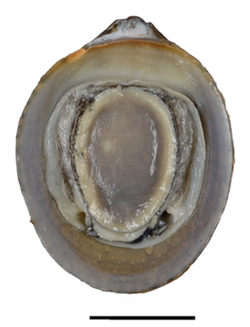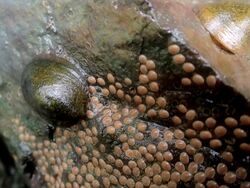Biology:Septaria porcellana
| Septaria porcellana | |
|---|---|

| |
| Shell of Septaria porcellana | |
| Scientific classification | |
| Kingdom: | |
| Phylum: | |
| Class: | |
| (unranked): | |
| Superfamily: | |
| Family: | |
| Subfamily: | Neritinae
|
| Tribe: | Neritinini
|
| Genus: | |
| Species: | S. porcellana
|
| Binomial name | |
| Septaria porcellana (Linnaeus, 1758)
| |
| Synonyms[1] | |
| |
Septaria porcellana is a species of freshwater snail, a gastropod mollusk in the family Neritidae.[2]
- Subspecies
- Septaria porcellana borbonica (Bory de Saint-Vincent, 1804)
- Septaria porcellana porcellana (Linnaeus, 1758)
Distribution
The geographical distribution of Septaria porcellana includes India, the Philippines , Indonesia, New Guinea and New Caledonia, found in still and swift currents on stones anywhere from a few meters from he sea to 5-6 kilometers inland.[3]
Description
The length of the shell attains 13.1 mm. The shell is symmetrical, cap-like and relatively deep and wide. The outside base color is yellow-brown with a black or purple-pink pattern of triangles and horizontal lines. Inside is white to light gray, septum narrow, and its edge curved and tinged yellow.[3]
Sexual dimorphism in the species presents as males being generally smaller than females. Male reproductive organs consist of a large flap-like penis with a papilla and a small auxiliary gland. Females have a ventral remnant of a spermatophore sac without spermatophores. [3]
Life cycle
Human use
This species is sold in the ornamental pet trade for use in freshwater aquaria.[4]
References
- ↑ Sartori, André F. (2014). Septaria porcellana. In: MolluscaBase (2017). Accessed through: World Register of Marine Species at http://www.marinespecies.org/aphia.php?p=taxdetails&id=818888 on 2017-11-27
- ↑ MolluscaBase eds. (2022). MolluscaBase. Septaria porcellana (Linnaeus, 1758). Accessed through: World Register of Marine Species at: https://www.marinespecies.org/aphia.php?p=taxdetails&id=818888 on 2022-05-24
- ↑ 3.0 3.1 3.2 Haynes, A. (2001). "A revision of the genus Septaria Férussac, 1803 (Gastropoda: Neritimorpha)". Annalen des Naturhistorischen Museums in Wien. Serie B für Botanik und Zoologie 103: 177–229. ISSN 0255-0105. https://www.jstor.org/stable/41767209.
- ↑ Ng, T. H., Tan, S. K., Wong, W. H., Meier, R., Chan, S. Y., Tan, H. H., & Yeo, D. C. (2016). "Molluscs for sale: assessment of freshwater gastropods and bivalves in the ornamental pet trade". PLoS ONE 11(8): e0161130. doi:10.1371/journal.pone.0161130
- Kerr, A. M. 2013. Annotated Checklist of the Aquatic snails of the Mariana Islands, Micronesia. University of Guam Marine Laboratory Technical Report 147: 1-18
- Eichhorst T.E. (2016). Neritidae of the world. Volume 2. Harxheim: Conchbooks. pp. 696–1366
- Benthem Jutting, W. S. S. van. (1958). Non-marine Mollusca of the island of Misool. Nova Guinea: A Journal of Botany, Zoology, Anthropology, Ethnography, Geology and Palaeontology of the Papuan Region. 9 (1): 293–338.
External links
- Linnaeus, C. (1758). Systema Naturae per regna tria naturae, secundum classes, ordines, genera, species, cum characteribus, differentiis, synonymis, locis. Editio decima, reformata [10th revised edition], vol. 1: 824 pp. Laurentius Salvius: Holmiae
- Sowerby, G. B. I. (1825). A catalogue of the shells contained in the collection of the late Earl of Tankerville: arranged according to the Lamarckian conchological system: together with an appendix, containing descriptions of many new species- London, vii + 92 + xxxiv pp
- Schumacher, C. F. (1817). Essai d'un nouveau système des habitations des vers testacés. Schultz, Copenghagen. iv + 288 pp., 22 pls
- Lesson, R. P. (1831). Chapitre XI. Mollusques, Annélides et Vers; par R.-P. Lesson. pp. 239-456 [15 Nov 1831]. In: Lesson R.P. 1830-1831. Voyage autour du monde, Exécuté par Ordre du Roi, sur La Corvette de Sa Majesté, La Coquille, pendant les années 1822, 1823, 1824 et 1825, sous le ministere et conformément aux Instructions de S.E.M. le Marquis de Clermont-Tonnerre, Ministre de la Marine; Et publié sous les auspices de son Excellence Mgr le Cte de Chabrol, Ministre de la Marine et des Colonies, par M.L.I. Duperrey, Capitaine de Frégate, Chevalier de Saint-Louis et Membre de la Légion d'Honneur, Commandant de l'Expedition. Zoologie, par M. Lesson. Tome Second. 1re Partie. Paris, Arthus Bertrand, Libraire-Editeur, Imprimerie de Firmin Didot. pp. 1–471
- Récluz, C. A. (1842). Prodrome d'une monographie du genre Navicelle. Revue Zoologique par la Société Cuvierienne. 4: 369-382
- Martens, E. von. (1897). Süss- und Brackwasser-Mollusken des Indischen Archipels. Zoologische Ergebnisse Einer Reise in Niederländisch Ost-Indien 4: 1-331, pls 1-12
- Abdou, A. (2021). New taxonomic and phylogeographic data on three nominal species of the genus Septaria Férussac, 1807 (Gastropoda: Cycloneritida: Neritidae). Zootaxa. 4915 (1): 28-40.
- Haynes, A. (2001). A revision of the genus Septaria Férussac, 1803 (Gastropoda: Neritimorpha). Annalen des Naturhistorischen Museums in Wien. Serie B für Botanik und Zoologie. 103: 177-229
Wikidata ☰ Q10931451 entry
 |



